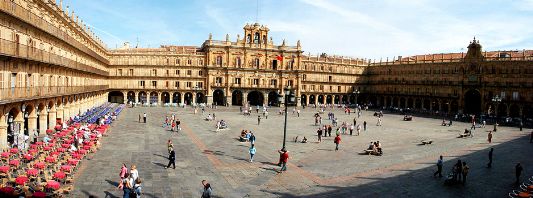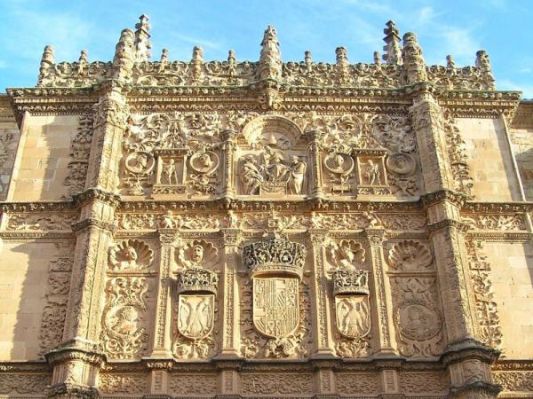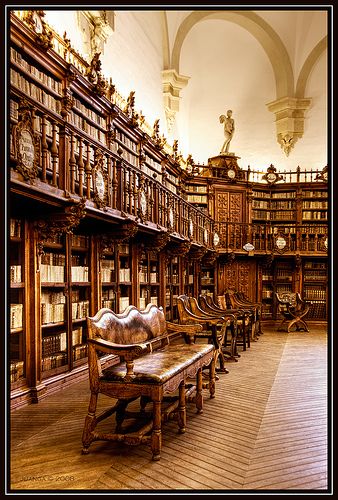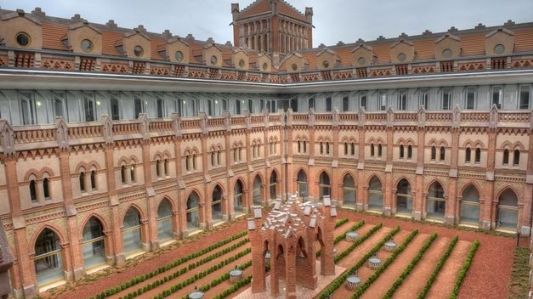Over two thousand years is sufficient time to amass all kinds of events, large and small, happy and dramatic, glorious or difficult. The Celtic tribes of the Vettones and Vacceos, Hannibal and the Romans; the re-founding of the city by Alfonso VI, following the sacking of Toledo by the Moors, the wars between the factions, the ruling of the nobility in the 14th and 15th centuries, the War of the Commons, the splendour of the XVI century when Salamanca was the epicentre of learning and worldly knowledge, the crisis of the Baroque period, the Peninsular War, and the isolation of the 19th and a good part of the 20th century, have moulded both the physical and the spiritual aspects of the city’s structure, identity and culture. UNESCO designated it a World Heritage City in 1988 and it became European Culture Capital in 2002.

With the Plaza Mayor, the Clerecía: the Jesuit seminary, the University and the New Cathedral, Salamanca is one of the essential centres of a dynasty of architects, decorators and sculptors from Catalonia, the Churriguera. This Churrigueresque style also exerted considerable influence in the 18th century in the countries of Latin America. The Roman bridge that spans the River Tormes south-west of the city is one of the numerous witnesses, that still stands today, to the 2,000-year history of ancient 'Salmantica'. However, only the arches on the city-side of the bridge are original, the rest date from the rebuilding of the bridge in the 18th century. This bridge is part of the renowned Ruta de la Plata, a route that was of major economic and strategic importance following the Roman occupation. Salamanca's monuments have an exemplary value: the Old Cathedral, the Salina Palace and above all the Plaza Mayor, the most sumptuous of the Baroque squares in Spain.

However, the city owes its most essential features to the University. The remarkable group of buildings in the Gothic, Renaissance and Baroque styles which, from the 15th to the 18th centuries, grew up around the institution that proclaimed itself 'Mother of Virtues, of Sciences and of the Arts' makes Salamanca, like Oxford and Cambridge, an exceptional example of an old university town in the Christian world. Although officially founded later than those of Bologna, Paris, Cambridge and Oxford, the University of Salamanca had already established itself in 1250 as one of the best in Europe even though it had been founded as a place of study in 1218 by order of King León Alfonso IX.

It followed the Bologna model, namely it gave preference to the study of Civil and Canon Law over theology and philosophy which were favoured at the University of Paris. During its period of greatest splendour, the 15th and 16th centuries, it was the head of the European Universities. It is currently the oldest university in Spain. One of the main features is the Fray Luis de León lecture hall, the reliefs along the stairwell of the cloister, and the Library, founded in 1254 by Alfonso X “the Wise”, with a collection that contains a large number of priceless manuscripts and pre-1500 publications. Amongst these priceless treasures is a copy of the Tohá and the so-called “libros redondos” that Torres Villaroel bought in Paris and which are in fact globes, but he gave them this name so that the librarian at that time would agree to pay for them. The Escuelas Menores courtyard leads to the "Cielo de Salamanca" (heaven of Salamanca). It represents an astrology programme that was undoubtedly involved with the teaching of astronomy and astrology at the University. In keeping with student tradition, if you want to breeze through your exams, you must first see the frog on the University facade. On almost all of the university buildings, you will find one of the famous "vítores" wall paintings. These were originally painted using bulls blood and symbolise the victory of the recently graduated Doctorate students over their books.

The most beautiful example of the Renaissance colleges in Salamanca is the Colegio de los Irlandeses built between 1527-1578 to house Irish students. Others ancient buildings are the Colegio de Huérfanos; the Colegio San Pelayo; the Colegio Santa Catalina; the Colegio San Ildefonso. The superb Baroque colleges of the 18th century are Colegio de la Ordén Militar de Calatrava, Colegio de San Ambrosio, and Colegio de l'Universitad Pontificia, with its marvellous patio, 'Salon des Actos' and monumental stairway. The more austere Colegio de Anaya was one of the last monuments of this institution to be built in a style inherited from the Middle Ages, along with the Colegio de Santa Maria de Los Angeles, founded in 1780; the latter incorporates the late Gothic style facade of the earlier Colegio de San Millán.

The Royal College of the Jesuit Order was built in part by Gómez de Mora in 1611. The missionaries that were trained went on to spread the Catholic Faith around the world. Nevertheless, the herculean construction task lasted another 150 years before it was completed at which time, in 1767, the Jesuit Order was expelled from Spain by Carlos III. The building was subsequently split into four, was abandoned and then suffered the scorn of war, ecclesiastical confiscation and finally ruin. It was in 1946 that it was reformed and was used to house the Pontifical University. Both the college and the private areas of the nuns have an upper gallery allowing them to go for strolls and enjoy the sun in the winter months, as the convent has neither allotment nor garden.

The Casa de las Conchas (House of Shells) is one of the most popular palaces of Salamanca and one of the best examples of Spanish Gothic civil architecture. It was commissioned in the late 15th and early 16th century by Don Rodrigo Arias Maldonado, a relative of the Catholic Kings and Knight of the Order of Saint James. The shells are the main ornaments of the building’s facade.
One of the aspects that generates a great deal of interest is why he chose the shells as the ornamental detail. Some believe that it was a show of pride by Maldonado for belonging to the order of Saint James. Others, undoubtedly more romantic, believe that the repetition of the shell, in heraldic terms, was an expression of love felt by Lord Rodrigo for his wife, Lady María.
Salamanca's Plaza Mayor is undoubtedly one of the most beautiful squares in Spain and in the world and one of the best examples of Baroque architecture in the Peninsula. Since work was completed on it between 1729 and 1755, this typical Castilian square, has been the meeting point for the people of Salamanca - who see it as their living room – and foreigners alike. Awarded the status of National Monument in 1935, in the technical and artistic accreditation it states that it is "the most decorated, proportionate and harmonious of all the squares of its period in Spain". It has 88 arches and a number of medallion reliefs. Currently, as in the past, the square is still the venue for the city’s major religious and civil celebrations: bull-fighting, processions and in the past, even executions. That is why some owners of the properties are able to rent out their balconies for certain events at a considerably high price.
.jpg)
Each year on 15 August, above the belfry of the City Hall they place a flagpole, on top of which stands the figure of a bull with the Spanish flag. The figure, which is given the name of "Mariseca", is placed there to announce the approach of the Salamanca festivals, and it is not removed until they are over.
The silhouette of the Cathedrals towers over the Salamanca skyline and its inside reflects the life and history of the city and the city’s residents. Together, standing side by side, they go to form a wonderful historical and artistic complex: the Old Cathedral and the New Cathedral. The new one, a fusion of Gothic, Renaissance and Baroque architecture. The Old one is Romanesque. To access the Old Cathedral, you must first go through the new one. As you walk through the door, you are taken back in time, this Romanesque church is home to an ancient, medieval spirit. Architecturally speaking, a defensive building, linked to the period of resettlement (work on its construction began in around 1509, of a people at war where the heroes of the time were the so-called warrior saints (Raimundo de Borgoña or Bishop Jeronimo). The San Martín Chapel is also known as the Aceite (oil) Chapel because it was used to store the earthenware jars of oil that were used to fuel the lamps in the Cathedral. The thickness of its wall meant that during the Spanish Civil War, it was used as an air-raid shelter, and even General Franco is reputed to have sheltered there.
Towards the end of the 15th century, the population of Salamanca underwent huge growth, thanks to the popularity and renown of the University. The Old Cathedral was now too small, and the mostly Gothic aesthetic and ideology of its interior made it a rather archaic venue and it was simply not very practical. So in 1513 work began on the construction of the New Cathedral, one of the last Gothic cathedrals to be built in Spain, and it was completed some two centuries later in 1733. Different architectural styles seem to randomly appear in its construction. The New Cathedral epitomises urban development. Its opulence reflects its triumph over its ideological rivals and of its parishioners. It is both the largest and the tallest building in the city. In 1755, the famous Lisbon earthquake seriously damaged the bell tower. The bell mechanism was damaged so the bell-ringer had to climb up to the bells to ring them. This tradition continues to this day and each 31 October, someone wearing a traditional Salamanca outfit climbs the tower and plays a Charrada a traditional Salamanca tune.
Considered by many to be the Spanish Renaissance city par excellence, it makes for a unique setting, both for its architectural and urban beauty which has survived the test of time and for its important role regarding humanistic thinking and the thirst for knowledge so prevalent in this historic period. Sunrise and sunset are magical moments. The light manages to transform both the interior of the buildings and their exterior, a singular light that bathes the gilt-coloured façades that reflect the famous people who once walked its streets, and whose presence can still be felt.
Best time of year to visit: All year but also at Easter.